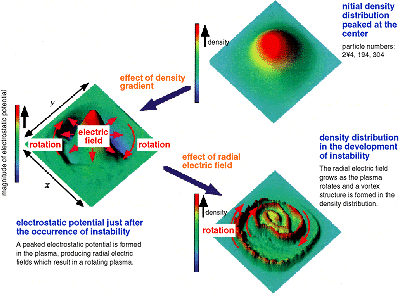The current density distribution in a high current, large tokamak
becomes peaked at the plasma center, which frequently causes instabilities
near the plasma center inducing internal fluctuations of the structure
of the confining magnetic field. Instabilities are observed as a recurrence
of sawtooth-like oscillations in electron temperature and/or density.
This internal instability is known to induce a sudden termination of
plasma current (disruption) in the crucial case. Theoretical studies
of internal instabilities have so far been developed on the basis of
a fluid model, regarding the plasma as a continuous body. In high temperature,
fusion plasmas, however, collective behavior of plasma particles becomes
more important for understanding the physical processes of this type
of instability.
We have been developing a detailed simulation study of microscopic processes
of the instability on the basis of a particle model that describes the
plasma behavior in terms of the motion of its constituent particles.
As a step to simulate actual experimental conditions as closely as possible,
a peaked distribution of plasma density is assumed as an initial condition,
(including a density gradient) as shown in Fig. 2-12. The simulation
has revealed that an electric field develops in the plasma as the instability
evolves, which was not predicted by the conventional fluid model. It
is also found that the resultant electric field interacts with the structural
fluctuations of the confining magnetic field, making the process more
complicated. As shown in Fig. 2-12 the interaction of the electric field
with the confining magnetic field produces plasma rotation, and a vortex-like
structure appears in the density distribution. In the final stage of
instability, the density distribution is flattened through the vortex
structures, however the current density distribution is found to remain
peaked at the center suggesting an instability-prone distribution, which
is consistent with experimental observations. |
